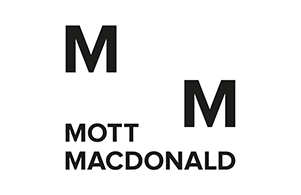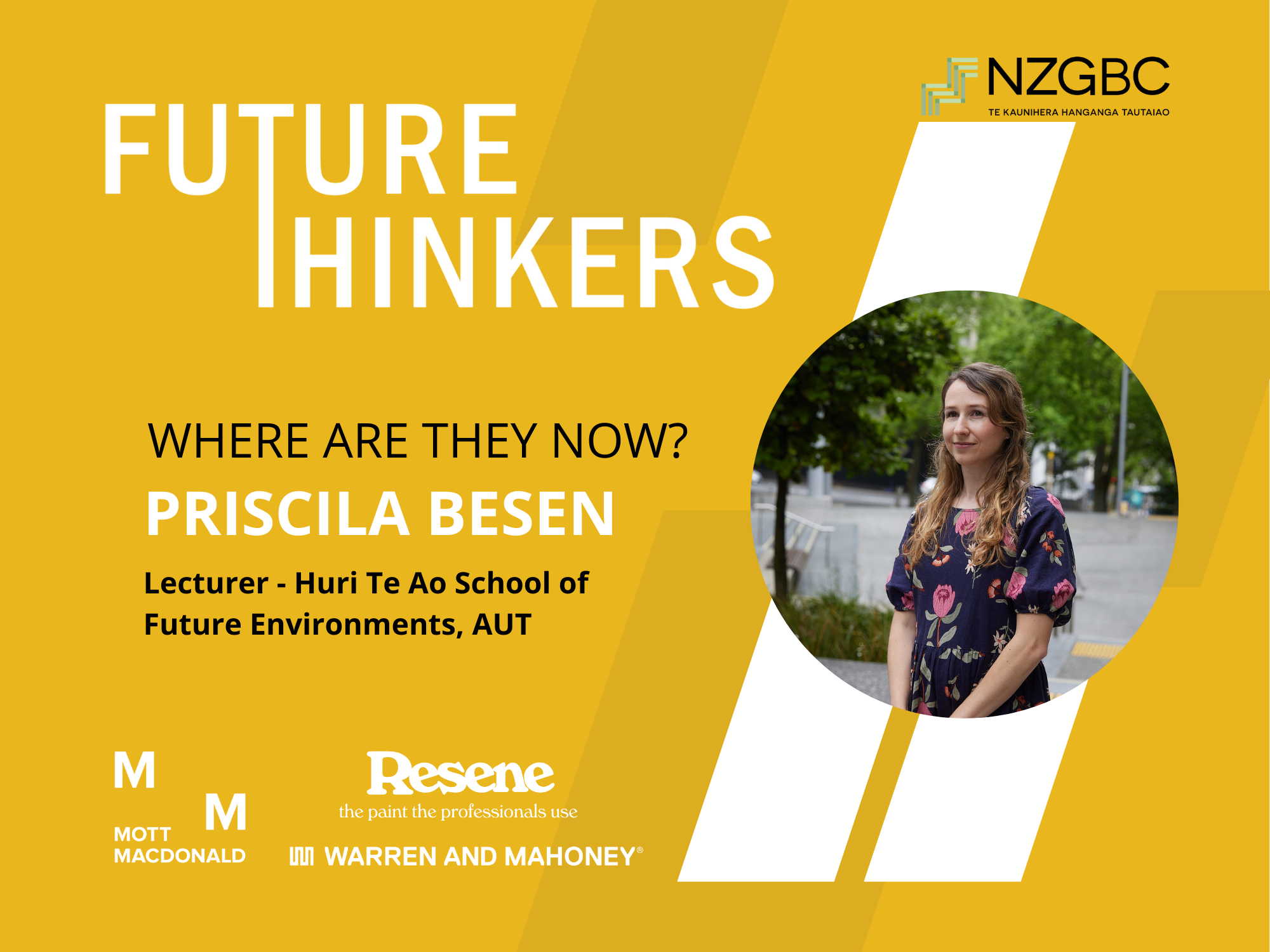Our Future Thinker of The Year awards brings together some of the most innovative, passionate and exciting up-and-coming voices in driving better futures through sustainability. Now in its sixth year, it’s safe to say that we’ve seen some inspiring young leaders go on to make their mark in the sector and become positive change-makers contributing to a greener built environment in Aotearoa.
Every year, our judging panel and the NZGBCD team is blown away by the diverse backgrounds and ambition of the nominees so through the “Future Thinkers, where are they now?” series we’re touching base with past finalists and winners, exploring the journey their careers have taken so far, their learnings, and thoughts on making the property and construction sectors more sustainable.
Priscila Besen
Priscila was a finalist in the 2019 Future of the Thinker of The Year awards. She is a lecturer in sustainable and regenerative architecture at Huri Te Ao School of Future Environments, Auckland University of Technology.
Priscila has a Bachelor of Architecture and Urbanism from Universidade Federal de Santa Catarina, a Master of Architecture in Sustainable Design, and a PhD in Architecture from The University of Auckland.
What drives your passion for your mahi in the sustainability space?
I’m passionate about the many solutions we already have that can improve our health and the health of our planet at the same time. There are so many synergies between improving people’s wellbeing and creating a positive impact on our environment, such as designing and retrofitting healthy buildings, creating urban spaces that encourage people to move around, to go outside and connect with nature. A regenerative built environment can bring so many benefits for us, for the environment, and for our future generations.
As a Lecturer at Huri Te Ao School of Future Environments at AUT you are on the forefront of new ideas for sustainability in Aotearoa’s built environment. What excites you in this space?
It’s been fantastic to teach at the Hoahoanga Architecture Programme at AUT, and I’ve been learning a lot from my colleagues and from students. We are seeing more and more students who care deeply about the future of our planet, and it is great to be in this environment where ideas are flourishing. It’s also great to see the focus of the programme on Mātauranga Māori, and how this can help us create a regenerative future for all, shifting conversations from human-centric to acknowledge all living beings and more-than-human around us.
What has been biggest professional challenge and how have you overcome it?
In my first years after finishing university and working as an architectural graduate, I worked on all types of projects, and many of them did not have a big focus on sustainability - due to lack of interest from clients, or in many cases due to limited budgets. Sometimes it was frustrating to see so many missed opportunities to improve the environmental performance of projects, but I always tried my best to do at least small changes to make the projects a bit better.
I tried to find cost-neutral ways to improve environmental performance. For example, designing a house with good solar orientation does not add additional costs, reducing paved areas can reduce costs and improve stormwater management, choosing local materials can be more cost-effective and reduce embodied carbon, designing in ways that keep existing trees on site and reducing earthworks whenever possible can be more cost-effective in many cases. So, to avoid feeling a lack of hope, I would focus on the small things that I could do in any kind of project. It was challenging to voice these ideas as a young graduate, as I still needed to learn a lot about buildings and construction in general, but I think I managed to bring a few good changes.
What has been your career highlight so far?
This Summer, I’ve been awarded a Best Paper Award for a Young Author from the International Journal “Building and Environment”. This is a well-known sustainability publication that I’ve read for many years, and last year I decided to submit a paper about my PhD research to them, written with my co-author and PhD supervisor Dr Paola Boarin. I was very happy that my paper had been accepted by them, as they are quite selective, receiving this award has been a big honour!
I am also really excited about a trip that I will make with a group of architecture students from AUT to Chile this year. I’m originally from Brazil, and I’ve been trying to connect my research here in Aotearoa NZ with universities in South America. So, I’m really excited about this opportunity to start connecting these two worlds, and I think this will be a career highlight for me.
Do you believe we are seeing positive change in Aotearoa to create a more sustainable built environment and what can we do better?
I think that there have been significant changes in the past few years, but we can still do a lot more. The increase in uptake of building certification tools such as Greenstar, Homestar, Passive House and Living Building Challenge has driven positive change and helped to measure the actual performance of projects.
I would like to see more encouragement to reuse existing buildings and structures. Through my PhD research, I learned so many ways we can retrofit existing and historic buildings to be healthier and energy-efficient. The more I learn about the impact of materials and construction, the more I think we should be prioritising building reuse over new construction as much as possible. Life-cycle thinking is needed across all sectors, and we need to think more about how our buildings can be adapted and evolve in future, how they can be deconstructed and recycled if needed. Another important area to improve is to ensure we have enough green spaces in our cities and understand how to balance densification with the provision of enough space for nature.
We are seeing bottom-up changes, coming from clients, designers and organisations; and we are seeing top-down changes through new policies. We need to continue to move from both directions, and I believe all actions count to have a better built environment for our future generations.
What actions can society and individuals take to continue to de-carbonise and create a more sustainable future?
I believe many people want to improve their homes to lower their environmental impacts, but many have limitations in budgets and don’t know where to start.
So, I encourage people to start with things that save them money. Living with a smaller footprint in a smaller building can save many resources and lower your overall carbon footprint. Rethinking consumption, buying less things and focusing on second-hand, repurposing materials and taking advantage of the sharing economy. Growing your own veges at home and planting natives can help with carbon sequestration.
Then, there are certain things that might cost more upfront but will save you money in the long term. Improving insulation in your house, choosing efficient heating devices and lighting, getting a heat recovery ventilation system for your home, replacing existing single-glazed windows with double glazing or adding secondary glazing, adding shading to windows, adding solar panels with battery storage to your home if you can. Choosing materials with low embodied carbon, and focusing on local materials also bring many benefits.
The combination of bottom-up and top-down transformation will help us decarbonise and transition to a better future for all. So, in addition to these individual actions at home, people can also have their say in policies from the government, as well as demand better practices from industry.
Can you describe what a low carbon, healthy city would look like?
I think it is a city with streets that prioritise people and nature, instead of being designed only for cars. A city with plenty of public green space and places for children to play. A city that offers a variety of low-carbon transport options – with generous footpaths, continuous cycleways, and frequent trains and buses. A city that is co-designed with the people living there, and where Indigenous knowledge and design is valued. A city with healthy, energy-efficient buildings, both old and new. A city that implements water-sensitive design and is resilient to flooding. There is a quote that says, “The future is already here – it's just not evenly distributed.” We already see many of these things in many areas of Auckland and other cities, but we just need to see all these solutions evenly distributed everywhere, both in our more privileged neighbourhoods and the less privileged ones.
If you could give any advice to yourself five years ago, what would that be?
I think I should have learned more about how to communicate ideas about sustainability in an effective and positive way. In the past, I tended to focus much on problems, and now I see that people pay more attention to communication that focuses on solutions and positive change.
Lastly, what do you love about your mahi?
I love seeing my students' creativity and the innovative projects they design to create a regenerative future. University is a very positive and future-focused environment, and it gives hope for a better future, and I hope these ideas make their way into practice. I love studying and learning, and sometimes it feels like a dream that I now get paid to do this!



